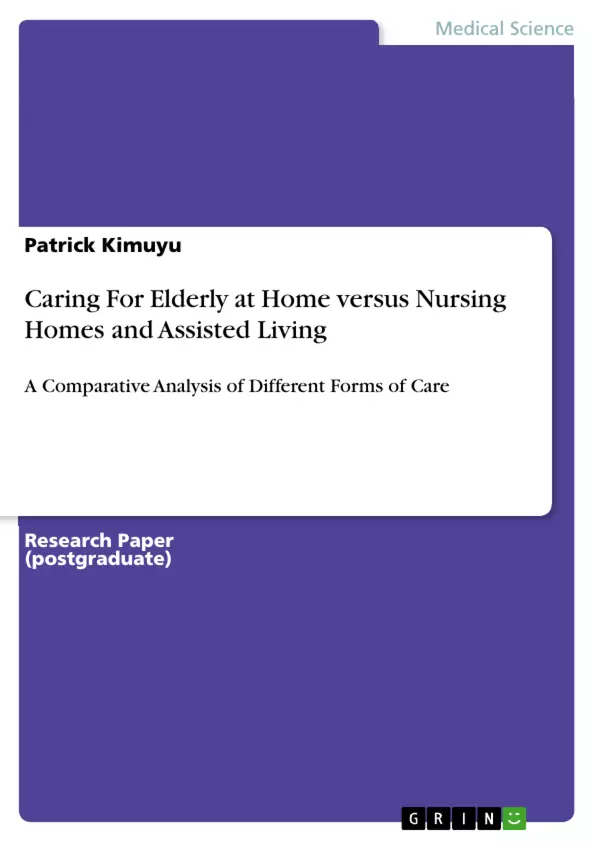This paper will provide an overview of caring for the elderly in which it will focus on caring for elderly at home verses nursing homes and assisted living.
Caring for the elderly is becoming an enormous challenge to the U.S healthcare system. It has become a significant public health issue whereby the elderly population requires extensive care from their families. Currently, the population of persons aged 65 years and above is estimated to be 39.6 million, which is equivalent to12.9% of the total U.S population. Research indicates that the percentages of elderly persons have increased significantly in the last decade. In 2000, the percentage of the elderly population was found to be 12.4%, so it has increased by 0.5% within a span of 10 years, and this is predicted to reach as high as 19% by 2030. This implies that the population of older persons will be about 72.1 million which will be more than twice their population in the year 2000.
In this context, care for the elderly will serve as the most principal approach in enhancing their health and social wellbeing. Caring for the elderly people involves numerous aspects, which require comprehensive evaluation to ensure that people at old-age enjoy a high quality of life. Ordinarily, elderly people are faced with health challenges owing to their aging bodies which are susceptible to illnesses. For instance, most old people experience mental degradation leading to memory loss. In addition, some people develop loss of vision and hearing abilities while others suffer from mental disorders such as Alzheimer’s and dementia. In theory, care-giving serves as the most principal requirement for the elderly for improved health. However, care-giving is usually faced with challenges owing to the complexity of decision making, availability of resources and experiences of care-givers. Ideally, elderly persons are supposed to be taken care of in a safe and healthy environment.
Inhaltsverzeichnis (Table of Contents)
- Introduction
- Forms of Care
- Home Health Care vs. Nursing Homes and Assisted Living
Zielsetzung und Themenschwerpunkte (Objectives and Key Themes)
This paper aims to provide an overview of the different forms of care available for elderly individuals, focusing on the advantages and disadvantages of home health care, nursing homes, and assisted living facilities. The paper examines the effectiveness, cost-efficiency, and impact on personal dignity and independence of each care option.
- Comparison of home health care, nursing homes, and assisted living
- Impact of care options on elderly health and well-being
- Cost-effectiveness of different care models
- Importance of personal dignity and independence in caregiving
- Role of family support in home health care
Zusammenfassung der Kapitel (Chapter Summaries)
- Introduction: This section introduces the increasing prevalence of the elderly population in the United States and the growing need for care services. It highlights the importance of ensuring a high quality of life for elderly individuals and emphasizes the challenges associated with caregiving, including decision-making, resource availability, and caregiver experiences.
- Forms of Care: This chapter outlines the three primary forms of care for elderly individuals: home health care, nursing home care, and assisted living. It provides a brief overview of each form, highlighting key features and differences in care provision, facilities, and caregiver involvement.
- Home Health Care vs. Nursing Homes and Assisted Living: This chapter delves into the comparative advantages and disadvantages of home health care, nursing homes, and assisted living. It explores topics such as the impact on recovery, cost-effectiveness, personalization of care, and promotion of personal dignity and independence. Additionally, the chapter highlights the importance of family support and the potential risks associated with institutionalized care.
Schlüsselwörter (Keywords)
The primary keywords and focus topics of this text are: home health care, nursing homes, assisted living, elderly care, quality of life, cost-effectiveness, personal dignity, independence, family support, and healthcare system.
- Quote paper
- Patrick Kimuyu (Author), 2016, Caring For Elderly at Home versus Nursing Homes and Assisted Living, Munich, GRIN Verlag, https://www.grin.com/document/381255



